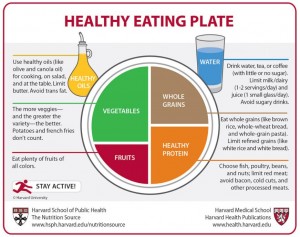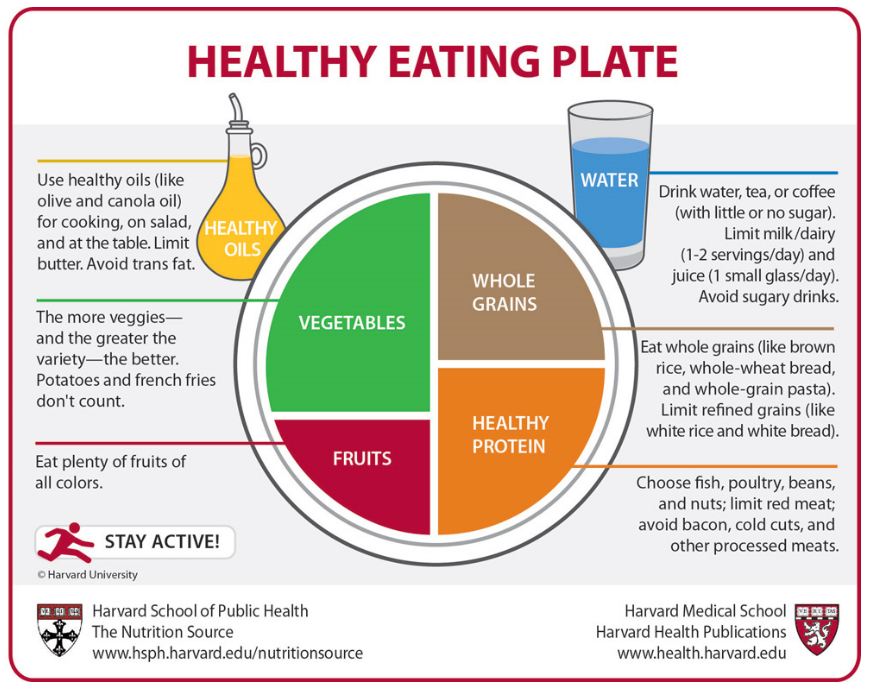 On Wednesday, September 14, Harvard Health Publications revealed a new Healthy Eating Plate icon developed by nutrition experts at Harvard School of Public Health with Harvard Health Publications, which the Harvard scientists say is intended to provide a simple visual guideline for a healthy diet that they claim is superior to the U.S. Department of Agriculture’s (USDA’s) MyPlate.
On Wednesday, September 14, Harvard Health Publications revealed a new Healthy Eating Plate icon developed by nutrition experts at Harvard School of Public Health with Harvard Health Publications, which the Harvard scientists say is intended to provide a simple visual guideline for a healthy diet that they claim is superior to the U.S. Department of Agriculture’s (USDA’s) MyPlate.
The Harvard Healthy Eating Plate (pictured at left and below) was revealed in a September 14, 2011 online article in Harvard Health Publications of Harvard Medical School.
In the article, the editors of Harvard Health Publications state, “[the Harvard Healthy Eating Plate] offers more specific and more accurate recommendations for following a healthy diet than MyPlate, developed by the U.S. Department of Agriculture and the Department of Health and Human Service.” “In addition,” they say, “the Healthy Eating Plate is based on the most up-to-date nutrition research, and it is not influenced by the food industry or agriculture policy.”
In a press release issued on September 14, the Harvard School of Public Health said that the Harvard Healthy Eating Plate “addresses important deficiencies in the [USDA] MyPlate icon.”
“Unfortunately, like the earlier U.S. Department of Agriculture Pyramids, MyPlate mixes science with the influence of powerful agricultural interests, which is not the recipe for healthy eating,” Walter Willett, Professor of Epidemiology and Nutrition and chair of the Department of Nutrition at Harvard School of Public Health, said in the Harvard press release. “The Healthy Eating Plate is based on the best available scientific evidence and provides consumers with the information they need to make choices that can profoundly affect our health and well being,” he said.
Harvard’s Healthy Eating Plate vs. USDA’s MyPlate
For comparison, here is a full-size copy of the new Harvard Healthy Eating Plate, and further below, the USDA MyPlate:

As illustrated, some of the differences are:
- More Detailed Guidance: The Harvard Healthy Eating Plate contains more detail, with notes to the consumer providing more specific guidance for each of the four major food groups represented on the plate.
- Whole Grains vs. Grains: The Harvard Healthy Eating Plate emphasizes whole grains, while MyPlate only mentions grain. In its accompanying press release, the Harvard School of Public health emphasized that, “Refined grains, such as white bread and white rice, act like sugar in the body. Eating too many refined grains can raise the risk of heart disease and type 2 diabetes.”
- Healthy Protein vs. Protein: The Harvard Healthy Eating Plate specifies that fish, poultry, beans, nuts are healthier than red meats and processed meats, while MyPlate only mentions protein.
- Vegetables Without Potatoes vs. Vegetables: The Harvard Healthy Eating Plate advises eliminating potatoes, specifying that potatoes and french fries don’t count as “vegetables,” while MyPlate only advises to eat vegetables.
- Oils and Fats: Harvard’s Healthy Eating Plate adds a note advising to avoid butter and trans fat, and advises using healthy oils like olive oil and canola oil for cooking, while MyPlate is silent on these matters.
- Dairy vs. Water & Limited Dairy: Harvard advises to drink water, limit dairy, and avoid sugary drinks, while USDA’s MyPlate advocates dairy with every meal. In its press release, the Harvard School of Public Health criticized the MyPlate icon for advocating dairy, saying, “[MyPlate] recommends dairy at every meal, even though there is little evidence that high dairy intake protects against osteoporosis but substantial evidence that high intake can be harmful.”
- Activity: “The Healthy Eating Plate reminds people to stay active, an important factor in weight control, while MyPlate does not mention the importance of activity,” Harvard pointed out in its press release.
Reactions to the Healthy Eating Plate
According to a report by ABC News, reaction to the Harvard Healthy Eating Plate has generally been favorable among nutrition scientists, including scientists quoted by ABC from institutions including Yale University Prevention Research Center, Family Health Care Center in Royal Oak, Michigan, Ochsner Medical Center in New Orleans, and Mayo Clinic in Rochester, Minnesota.
Some nutritionists, however, were quoted by ABC as offering critiques of certain aspects of the Harvard approach. Some said that dairy should not be limited for children. Another said that whole grains may not need as much emphasis if the overall balance of foods recommended in MyPlate is followed. And, one suggested that the Harvard icon may offer too much detail, making it too complicated for some consumers easily to follow. However, overall, these nutritionists too expressed support for Harvard’s effort to promote healthy eating.
In contrasting the detail of the Harvard Healthy Eating Plate to the simplicity of USDA’s MyPlate icon, it should be noted, however, that in presenting the MyPlate icon, the USDA includes links to, and specifically advises that the MyPlate icon is intended to be used in conjunction with, the very detailed 2010 Dietary Guidelines for Americans issued by USDA and HHS, as well as Interactive Tools for Dietary Guidance provided by USDA to help you plan a healthy menu.
Purpose of the Harvard Healthy Eating Plate
“We want people to use this as a model for their own healthy plate or that of their children every time they sit down to a meal—either at home or at a restaurant,” said Eric Rimm, Associate Professor of Epidemiology and Nutrition at Harvard School of Public Health and a member of the 2010 U.S. Dietary Guidelines Advisory Committee.
According to the Harvard School of Public Health, “The Healthy Eating Plate is based on the latest and best scientific evidence which shows that a plant-based diet rich in vegetables, whole grains, healthy fats, and healthy proteins lowers the risk of weight gain and chronic disease. Helping Americans get the best possible nutrition advice is of critical importance as the U.S. and the world faces a burgeoning obesity epidemic. Currently, two in three adults and one in three children are overweight or obese in the U.S.”
In conclusion, Anthony Komaroff, Professor of Medicine at Harvard Medical School and editor in chief of Harvard Health Publications, said: “One of the most important fields of medical science over the past 50 years is the research that shows just how powerfully our health is affected by what we eat. Knowing what foods to eat and in what proportions is crucial for health. The evidence-based Healthy Eating Plate shows this in a way that is very simple to understand.”
More Information
See a detailed Comparison of the Healthy Eating Plate and the USDA’s MyPlate, provided by Harvard Health Publications;
See Healthy Eating: A guide to the new nutrition, available from Harvard Health Publications; and
Eat, Drink, and Be Healthy, a “national bestseller debunks dietary myths and presents Dr. Willett’s New Healthy Eating Pyramid, a healthier guide to nutrition than the recently revised USDA pyramid,” according to Harvard Publications.
See the HelpingYouCare™ reports on:
MyPlate Icon Replaces Food Pyramid
New Dietary Guidelines for Americans Issued by USDA and HHS
Which Foods Are Linked to Highest Weight Gain Every 4 Years?
Special Vegan Diet Lowers Cholesterol Significantly, Study Finds; and
How Do People Lose Weight & What Can Be Done About the Obesity Epidemic?
And see, the HelpingYouCare™ resource pages on Wellness/ Healthy Living for Seniors & Caregivers, including:
Diet & Nutrition: Physical Wellness;
Sleep, Hygiene, Quit Smoking & Other Healthy Practices: Physical Wellness;
And our resource pages on other areas of wellness.
_____________
Copyright © 2011 Care-Help LLC, publisher of HelpingYouCare™.












Recent Comments from our Online Community